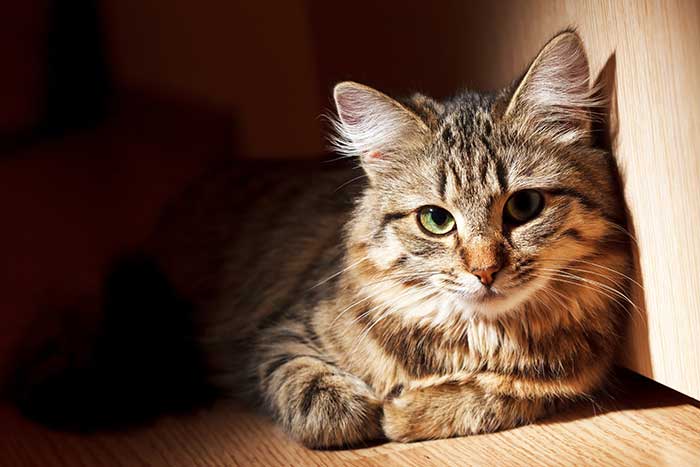Cats are some of the most finicky pets. They can be happy and cuddly this moment and become aggressive and unpredictable the next moment.
As a cat owner, you should always prepare yourself for both good and bad days. One of the naughtiest behaviors that your cat can resort to is peeing in the sink.
Regardless of how cute and sweet your feline friend is, the sight of a cat peeing in sink is anything but cute. It’s worse if the cat also poos in the sink. So, like any concerned pet parent, you might find yourself wondering, why is my cat peeing and pooping in the sink?
Well, there are numerous reasons why your cat might resort to peeing or pooing in the bathroom or kitchen sink. In most cases, it’s due to problems with the cat’s litter box. However, it could also happen that your cat has forgotten to use its litter box or that it finds your sink appealing in some way. Worse yet, your cat might resort to peeing in the sink due to an underlying medical condition, especially diseases that affect its urinary system.
Whichever the case, the onus is on you to establish the reasons and redirect the behavior as soon as you can.
Table of Contents
What’s Wrong with Cats Peeing or Pooing in Bathroom Sinks?
A foul smell is an immediate concern with cat urine or poo in your bathroom or kitchen sink.
You must already be familiar with the stench that’s associated with cat litter boxes that go uncleaned for extended periods of time.
Regardless of the location of dirty cat litter boxes, the stench they often exude has a way of infiltrating the entire house. Now, imagine if that smell was concentrated in your less-ventilated kitchen or bathroom!

In addition to the foul smell associated with cat urine in your sinks, there are also public health issues to contend with.
If left unattended for longer durations, cat urine usually starts to produce ammonia fumes. Besides its toxicity, ammonia is a risk factor for various respiratory conditions, including asthma attacks and severe breathing problems.
Toxoplasmosis is another health risk that might result from cat urine in sinks. Basically, toxoplasmosis is a medical condition caused by a parasite known as Toxoplasma gondii that’s spread by various agents, including cat urine and cat poo. The infection usually presents flu-like symptoms in humans, as well as muscle aches, headache, and tender lymph nodes.
Evidently, there are several reasons why cat pee should never find its way in your kitchen and bathroom sinks. Even if you don’t suffer any of the problems highlighted above, cat urine in your sinks is definitely an eyesore.
But because you can never predict your feline friend’s next behavior, you might never know when it’s about to relieve itself in your sink.
Fortunately, you can establish the underlying reasons behind this unbecoming behavior and take the necessary measures to prevent or redirect it.
Why Do Cats Pee or Poop in the Bathtub or Kitchen Sink?
The following are some of the reasons why your feline friend might find it convenient to pee in your sinks.
1. Training Problems
Cats, like all trainable animals, tend to forget. You may have trained your cat to pee in its litter box alright. However, it could happen that the cat has innocently forgotten its litter training. When this happens, the cat will go looking for an optimal spot to pee. And your sinks might just happen to be some of these prime spots.
Issues of forgetting litter training are common among very young and very old cats.
Remember that kittens have a lot going on in their minds and are always ready to explore new adventures. Sometimes, they may just be exploring your kitchen and decide to relieve themselves in your sinks.
It shouldn’t be so much of a concern if this happens occasionally. But if it happens every day, then the chances are that the kitten may have converted your sinks into its litter box.
On the other hand, older cats normally face issues with brain degeneration, which might affect their memory.
The most common cause of memory loss in senior cats is feline senile dementia, which is also known as cognitive dysfunction system (CDF). Besides a gradual memory loss, feline senile dementia may also affect your cat’s sense of awareness, responsiveness to stimuli, and learning curve.

2. Issues With The Cat’s Litter Box
Another possible reason why your cat keeps peeing in sink is that there could be issues with its litter box. Some of the potential problems with your cat’s litter box include;
i. Litter box is dirty
It’s undeniably true that cats are clean animals. Cats are known to spend up to 50% of their waking hours grooming themselves.
As a matter of fact, that’s one of the main reasons why many pet parents choose cats over dogs. So, since cats are inherently clean, it makes sense that your cat will not wish to be associated with dirty litter boxes.
ii. Litter box is too small
Peeing and pooing should be comfortable experiences. But when your cat’s litter box is too small, the animal may feel like they’re putting too much effort to use the litter box. That’s when the cat will look for alternative places to relieve itself.
- Perfect for Big Cats and Multi-Cat Homes: The Modkat XL Litter Box is designed for large cats and households with multiple feline...
- Versatile Entry Options to Suit Every Cat: Configure as a top-entry to keep floors clean and minimize spillage, or use as a...
- Walk-Off Lid Keeps Your Floors Clean: The top-entry lid doubles as a walk-off mat, effectively catching stray kernels to keep your...
Last update on 2025-04-16 / Affiliate links / Images from Amazon Product Advertising API
iii. Litter box is inaccessible
‘Inaccessibility’ here could mean so many things. First, the litter box may be covered or could have tipped over.
Most cats are not intelligent enough to uncover their litter boxes or bring them into an upright position for use. Why go through the trouble when they can pee in the kitchen sink anyway?
Another aspect of inaccessibility lies in the location of the litter box. Due to their obsession with cleanliness and their secretive nature, cats prefer their litter boxes to be placed in relatively hidden areas.
Having your cat’s litter box in the open might cause the cat to shy away from using it. It’s worse if the cat is skittish and its litter box happens to be in a place that’s characterized by heavy human traffic, such as the hallway.
But while it’s important to hide your cat’s litter box from plain sight, it shouldn’t be entirely inaccessible for the cat. If you place the litter box in reasonably inaccessible areas, such as high shelves or tight rooms, the cat may not be patient enough to go looking for it.
Lastly, you should confirm if the location of the litter box contains stimuli that might upset or frighten your cat. For instance, your cat’s litter box shouldn’t be too close to flashing lights, unsettling sounds, or unpleasant smells.

iv. Shared litter box
As a pet parent, you don’t need a professional vet to remind you that cats should have their own litter boxes.
Just like food bowls, shared litter boxes are known to trigger undue confrontations among cats. That’s ostensibly because cats are highly-territorial animals, and will jealously guard whatever they consider their own.
Territoriality is common among spraying male cats. So, your male cat peeing in sink could be indicative that the cat feels frightened by its older male counterparts. However, females are known to be just as territorial as males, especially when they’re nursing.
All in all, if you have more than one cat, never imagine that they can use the same litter box, even if the cats seem to get along just fine.
Usually, the dominant cat will lay claim to a shared litter box, forcing the submissive ones to start peeing in other unlikely places like your kitchen sink.
v. Litter box triggers bad memories
This is another common litter-box related reason that might cause cats to start peeing in sinks. Sometimes, cat peeing in sink and bathtub means that the cat associates its litter box with a bad memory, such as dangerous catfights.
Last update on 2025-04-16 / Affiliate links / Images from Amazon Product Advertising API
vi. Litter box isn’t attractive
Just like humans, cats have their own idea of what’s attractive and what’s not. So, you shouldn’t overrule the fact that your kitto doesn’t like the color or shape of its litter box.
While cats generally see the world in black and white, research shows that most cats are attracted to bright colors, such as red and orange. In terms of shapes, cats prefer circular and oval shapes, as these give them a sense of warmth.
3. Changes In Routine
Cats are creatures of habit. A slight disruption in their routines is all it takes to throw them off balance.
Now, there are numerous routine changes that might cause your cat to abandon its litter box and start peeing in your sink.
Examples include;
- Bringing home a new pet;
- Replacing your furniture;
- Home renovation or refurbishment;
- A new baby;
- Death in the family; and
- Changes with the cat’s routine like new feeding or sleeping time

4. Laziness
One of the frequently asked questions by cat owners is, ‘I caught my cat peeing in the sink, what could be the cause?’
Well, as strange as it sounds, your feline friend peeing in the sink could be suggestive of laziness.
In most cases, feline laziness results from unhealthy feeding habits and sedentary lifestyles. When it happens, the cat pees anywhere, including your kitchen, furniture, bed, etc.
5. Your Cat Loves The Sink
Unknown to you, your cat may have developed a love affair for your kitchen and bathroom sinks. Maybe the cat loves the color of the sink or its shape. Perhaps the cat is enchanted by the serenading sound of water draining down the sinks.
Or, in the case of kitchen sinks, your cat may be drawn to the kitchen by the inviting aroma and the thought of getting a quick snack.
6. Underlying Medical Condition
After ruling out all the above possible causes of cats peeing in sinks, what you’re normally left with is an underlying medical condition.
We’ve already mentioned feline senile dementia as a major cause of memory loss among older cats, which could cause them to forget their litter training.
Other common diseases that could interfere with your cat’s bladder functions include urinary tract infection, bladder inflammation (cystitis), and kidney stones. But what if my cat is peeing in sink but there’s no UTI?
You might want to check if the cat has arthritis. Generally, if your cat is suffering from any disease that causes pain while emptying its bowels or bladder, the cat will associate its litter box with the pain. That’s what makes it to start peeing in the wrong places like your sink.
How to Stop Your Cat From Peeing In Sink
We’ve already gone through some of the possible reasons why your cat could be peeing in sink. So, how can you prevent your cat from urinating in your sink?
Generally, the solution that you adopt will depend on the cause. So, the very first thing to do is uncover the underlying reason behind this aberrant behavior.
We will briefly go through some of those solutions, depending on their individual causes.
1. Retrain the Cat to Use Its Litter Box
If it happens that your cat has forgotten its litter box training, the best solution here is to retrain the cat.
Right off the bat, let’s emphasize that litter box training, as with all other forms of training, should be undertaken when cats are still young. But as we already indicated, age-related memory loss could cause the cat to forget its litter box training.
When retraining your cat to use its litter box properly, follow the same approach that you used while training it the first time. That means using positive reinforcements, such as food treats.

2. Correct Litter Box Issues
Another common tip to stop cat from peeing in sink is to correct whatever issues there might be with his litter box. The following are some of the ways to go about it.
i. Litter box is dirty
Always empty your cat’s litter box 2 or 3 times a day and clean it at least once a week.
ii. Litter box is too small
There are no two ways about this, you’ll need to get your kitto a larger litter box.
Generally, choose a litter box whose size is relative to the size of the cat, as opposed to the size of the litter box’s location.
Experts advise purchasing a litter box that’s about 1 ½ times bigger than the size of your cat.
- NAMED BEST CAT LITTER BOX UPGRADE: The New York Times Wirecutter named the Modkat Flip Litter Box the best cat litter box upgrade....
- 3-POSITION LID: The innovative 3-position flipping lid is a unique feature that sets Flip apart from traditional litter boxes. The...
- STOPS LEAKS AND SCATTER: The full-height, seamless base effectively prevents leaks and litter scatter. It is perfect for cats who...
Last update on 2025-04-16 / Affiliate links / Images from Amazon Product Advertising API
iii. Litter box is inaccessible
There are a few ways to ensure that your cat’s litter box is accessible. First, place the litter box in areas where the cat feels safe and comfortable relieving itself. That should be away from human foot traffic but not in too tight spots.
Another way to make your cat’s litter box accessible is to ensure that each cat gets its own litter box. That will go a long way in averting undue fights and confrontations. You might consider getting an extra litter box and placing it in a spare room so that skittish cats have more options.
You should also check your cat’s litter box from time to time and ensure that it’s not covered or tipped over.
Lastly, ensure that your cat’s litter box is free from unsettling stimuli, such as harsh sounds, foul smells, or flashing lights. If you can, avoid auto-cleaning litter boxes. The light and noise given by the automatic cleaning actions can scare off your cat, especially if your cat feels claustrophobic.
3. Go Slow On Routine Changes
While you cannot help changing your routine (or the cat’s routine) from time to time, you should always go slow on it.
For instance, before bringing a new cat home, prepare a separate location for feeding, playing, and roaming. These should preferably be places that the resident cat doesn’t lay claim to.

4. What If Your Cat Has A Love Affair For Your Sinks?
The best way to go about this is to make the sink inaccessible for the cat.
You may consider placing objects in the sink to create physical barriers. Another excellent tip is to use cat deterrents in your kitchen or bathroom. Examples include installing motion-sensor lights and spraying perfumes.
If the cat loves the sight of water flowing out of your kitchen taps, how about you consider getting your feline friend a cat water fountain?
PetSafe Cat and Dog Water Fountain is designed to encourage your cat to drink more often. It’s designed with replaceable carbon water filters that eliminate bad tastes and odors.
The fountain imitates the flow of water from faucets and is instrumental in keeping your cat from the kitchen and bathroom sinks.
5. Addressing Underlying Medical Condition
If you suspect that your feline friend is suffering from an underlying medical condition, you should enlist the services of your vet immediately.
The vet will be able to diagnose the cat and determine whether peeing in the sink has anything to do with its sickness. After that, they’ll recommend the right treatment option.

Other Ways on How to Stop Cat From Peeing In Bathtub
In addition to the above methods, you can also prevent your cat from peeing in the sink by;
✔ Investing in scat mats,
✔ Locking the kitchen or bathroom door to prevent access to these areas, and
✔ Installing calming pheromones, such as Feliway, in your kitchen or bathroom.
Now, it could happen that your cat has already relieved itself in your sink and you’re now wondering, how do I get rid of cat urine smell in my sink? That would require investing in an enzymatic spray like this Pet Stain & Odor Miracle Enzyme Cleaner.
The product is effective against cat urine, feces, drool, and vomit. You can use it on all kinds of surfaces, including carpets, hardwood, leather, rugs, etc.
Conclusion
If your cat started peeing in sink and you’re wondering what the reasons behind this strange behavior are, just note that there’s a wide range of possible causes.
Thankfully, there are effective solutions you can adopt and prevent the behavior or at least redirect it.
Checkout Our Favorite Cat Products
1. Best Online Course For Cat Parents
Our favorite: The Cat Language Bible (How to Finally Understand And Speak to Your Cat) – A new form of cat to human communication that many cat owners have dreamed about… but few have actually thought possible.
2. Best Vacuum to Tackle Pet Hair
Our favorite: ORFELD Cordless Vacuum – Engineered for homes with pets. With features and tools that dig out dirt, hair and allergens everywhere your pet gets.
3. Best Immune Support For Cats
Our favorite: Tomlyn Immune Support – Best Supplement for Cats and Kittens.










